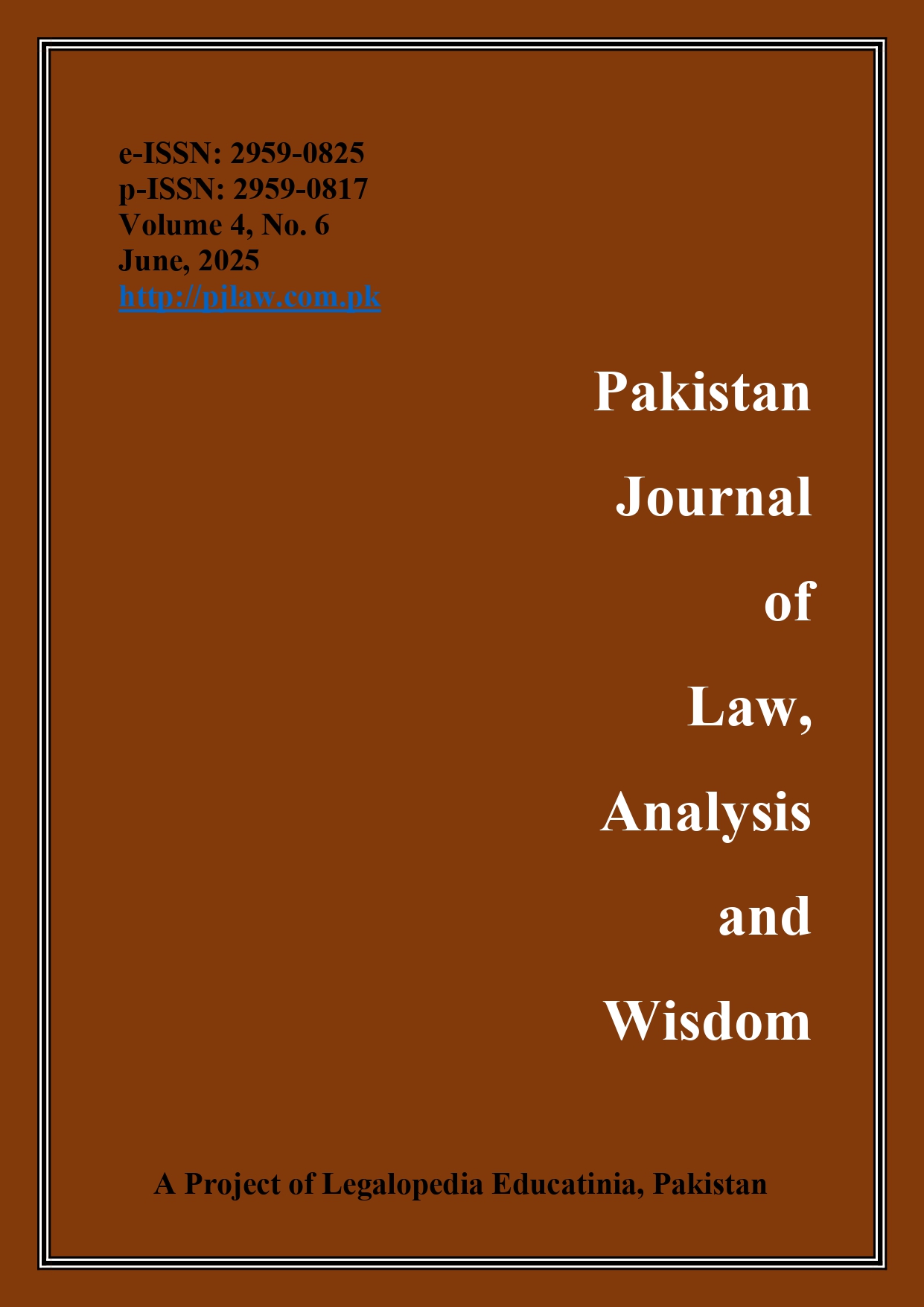Women’s Property and Inheritance Rights in Pakistan: A Legal and Socio-Cultural Analysis
Keywords:
Women's Rights, Inheritance Law, Socio-Cultural Barriers, Judicial EnforcementAbstract
This research article examines the complex legal and socio-cultural issues relating to the inheritance rights of women in Pakistan. Even though Islamic law and the Constitution of Pakistan guarantee these rights, women still suffer from rampant cases of disinheritance due to cultural practices, ignorance, and poor enforcement by institutions. The study also identifies key informal barriers to justice, including socio-cultural stigma and economic dependency, alongside court-centric biases, as well as global legislative frameworks, relevant constitutional provisions, and laws of Pakistan. A more thorough discussion is devoted to judicial activism, recent legal changes, and suggestions on strengthening implementation and awareness campaigns. These findings emphasize the gap that exists between practice and theory and propose policy recommendations to reduce this gap.
References
ADB. (2014). Legal empowerment of women in Asia: Case studies from Pakistan. Asian Development Bank.
AGHS Legal Aid Cell. (2020). Legal aid and women’s access to property in Pakistan. Lahore: AGHS.
Ali, S. S. (2017). Gender and human rights in Islam and international law: Equal before Allah, unequal before man? The Hague: Kluwer Law International.
Aurat Foundation. (2017). Inheritance rights of women: Research and policy brief. Islamabad: Aurat Foundation.
Chakwal Widow’s Inheritance Case, SC (2024, September 25).
CLC. (2011). Mukhtar Bibi v. Bashir Ahmed, 2011 CLC 946 (Lahore High Court).
CLC. (2012). Nasira Khatoon v. Bashir Ahmed, 2012 CLC 1984 (Karachi High Court).
Code of Civil Procedure, 1908. (Government of Pakistan, 1908).
Constitution of the Islamic Republic of Pakistan. (1973). Government of Pakistan.
Engineer, A. A. (2008). The Qur'an, women and modern society. New Delhi: New Dawn Press.
Government of Pakistan. (1908). Code of Civil Procedure.
Government of Pakistan. (1962). Muslim Personal Law (Shariat) Application Act. Retrieved from https://pakistanlaw.gov.pk
Government of Pakistan. (2011). The Criminal Law (Amendment) Act, 2011: Prevention of anti-women practices. Ministry of Law and Justice.
Government of Punjab. (2020). Enforcement of Women’s Property Rights Act.
Government of Punjab. (2021). Punjab Land Records Authority digitalization report.
HRCP. (2021). State of human rights in 2020. Human Rights Commission of Pakistan.
Hussain, J. (2012). Islamic law and society: An introduction. Edinburgh University Press.
Ibn Majah. (n.d.). Sunan Ibn Majah, Hadith No. 2703. Dar-us-Salam Publications.
Kamali, M. H. (2008). Shari‘ah law: An introduction. Oneworld Publications.
Khan, N., & Qureshi, T. (2019). Invisible inheritance: Barriers to women’s access to property in Pakistan. Islamabad: UN Women Pakistan.
Khan, R. (2020). Patriarchy and women's economic rights in Pakistan. Journal of Gender & Law, 12(1), 33–49.
Khan, S., & Zubair, S. (2019). Pashtunwali and women’s inheritance rights: A conflict of culture and law. Pakistan Journal of Legal Studies, 8(2), 14–29.
Ministry of Human Rights. (2022). Legal aid and human rights programs annual report.
National Commission on the Status of Women (NCSW). (2021). Women's rights to inheritance in Pakistan: Challenges and recommendations. Islamabad: NCSW.
NCSW. (2021). Women's access to inheritance in Pakistan: Status, challenges, and policy options. Islamabad: NCSW.
NG v. Muhammad Shafique, PCrLJ 123 (2021 Lahore).
Nowak, M. (2005). U.N. Covenant on Civil and Political Rights: CCPR Commentary (2nd ed.). N.P. Engel.
PLD. (2022). Pakistan Law Digest. Lahore: PLD Publishers.
Punjab Government. (2020). Enforcement of Women’s Property Rights Act. Retrieved from https://punjablaws.gov.pk
Qur’an. (n.d.). Surah Al-Nisa [4:7–12, 4:176].
SCMR. (1994). Mst. Nisar Fatima v. Maulvi Abdul Qayyum, 1994 SCMR 28.
SCMR. (2005). Mst. Sakina Bibi v. District Collector, PLD 2005 SC 69.
SCMR. (2008). Mst. Bashiran v. Muhammad Akhtar, 2008 SCMR 864.
SCMR. (2020). Sughran Bibi v. State, 2020 SCMR 2014.
Shahid, N. (2019). Internalized patriarchy and women's silence on inheritance rights in Pakistan. Feminist Review Pakistan, 3(2), 45–60.
Shirkat Gah. (2019). Understanding women’s property rights: Legal, cultural, and administrative perspectives. Lahore: Shirkat Gah Women’s Resource Centre.
Shirkat Gah. (2019). Women, law and society: A case study of women’s property rights in Pakistan. Lahore: Shirkat Gah Women’s Resource Centre.
Siddique, O., & Javed, A. (2020). Constitutional law of Pakistan. Oxford University Press.
UN CEDAW. (1979). Convention on the Elimination of All Forms of Discrimination Against Women. United Nations.
UN CEDAW. (2018). Concluding Observations on the Fifth Periodic Report of Pakistan. CEDAW/C/PAK/CO/5.
UN Women. (2020). Women’s access to justice and property in Pakistan. UN Women Pakistan.
UNESCO. (2022). Pakistan education statistics 2021–22. United Nations Educational, Scientific and Cultural Organization.
United Nations Human Rights Committee (UNHRC). (2016). General Comments and State Reports: ICCPR and ICESCR. https://www.ohchr.org
United Nations. (1948). Universal Declaration of Human Rights. https://www.un.org/en/about-us/universal-declaration-of-human-rights
Zia, A. (2018). Faith and feminisms in Pakistan: Religious agency or subordination? Critical Muslim Studies Journal, 6(1), 67–82.
Downloads
Published
Issue
Section
License
Copyright (c) 2025 Dr. Parveen Gul, Ms. Bushra Zeb, Ms. Kainat

This work is licensed under a Creative Commons Attribution-NonCommercial 4.0 International License.











 LEGALOPEDIA EDUCATINIA (PVT) LTD
LEGALOPEDIA EDUCATINIA (PVT) LTD